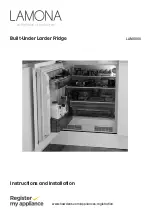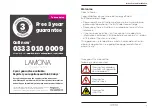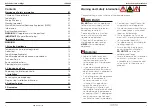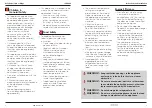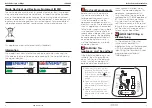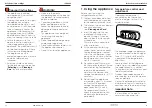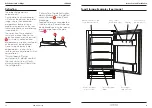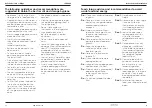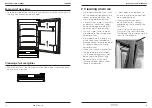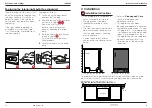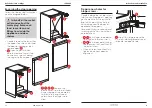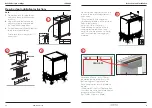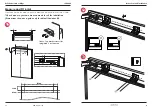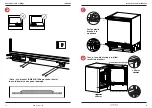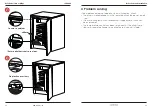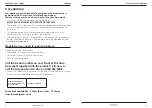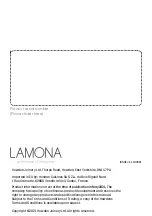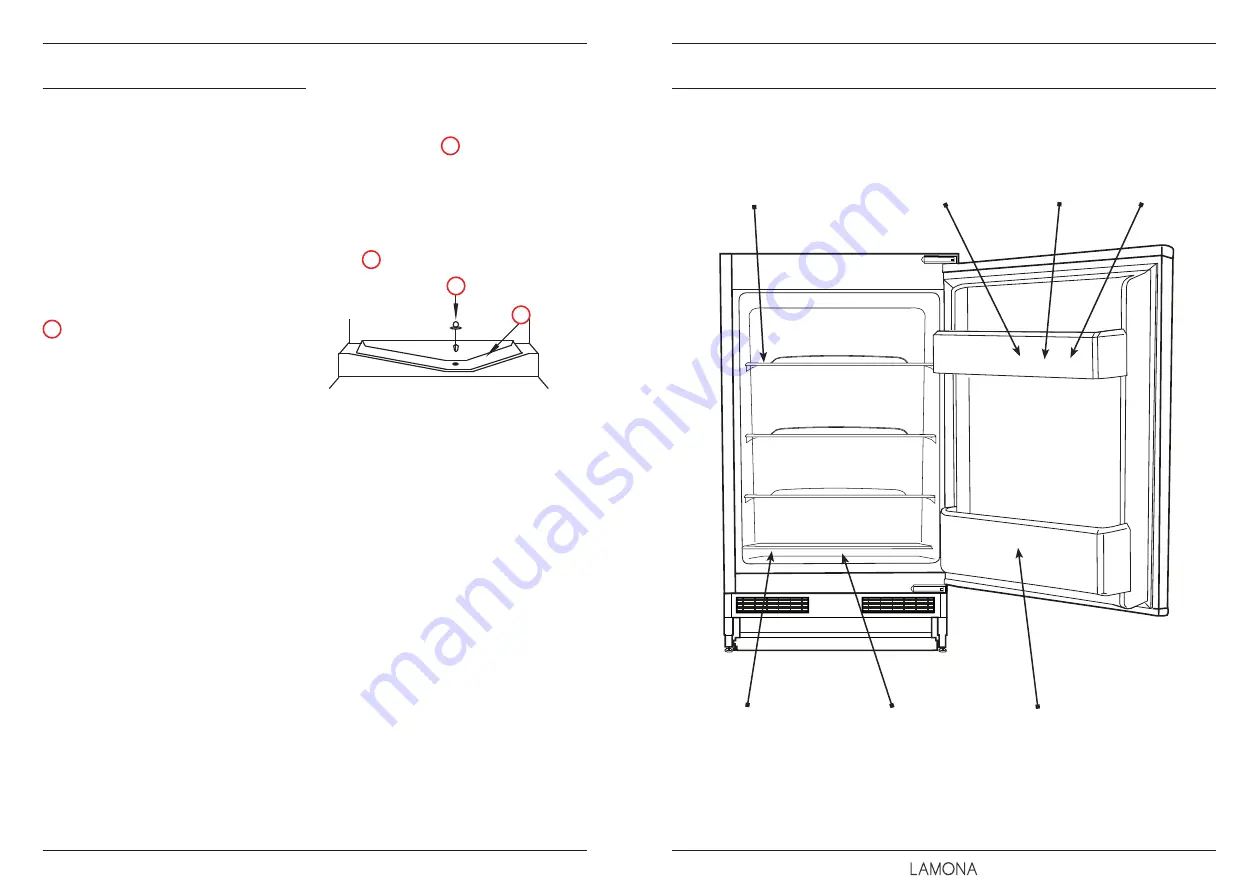
12
13
www.howdens.com
Built-Under Larder Fridge
LAM6000
Instructions and Installation
Defrosting
The larder fridge defrosts
automatically.
During defrosting water droplets
will form at the back of the larder
fridge, where the concealed
evaporator is located. Some
droplets may remain on the rear
liner and refreeze when defrosting
is completed.
The water from these droplets
runs down a drain tube via the
collection channel at the rear wall
1
. This water is collected and
evaporated in a special container
at the back of the appliance.
Do not use pointed or sharp-
edged objects, such as knives,
forks to remove any droplets which
have refrozen.
*Ensure foodstuffs and
containers etc. do not contact
the rear wall as ice will form
across and water will leak into
the refrigerator.
If at any time the defrost water
does not drain from the defrost
drain channel
1
, check for a
blockage.
Food particles may have blocked
the drain tube. The drain tube can
be cleared by pushing the special
plastic plunger down the drain
tube
2
.
Food Storage Examples (See image)
•
Fresh wrapped produce can be placed on the shelf.
•
Fresh fruit and vegetables should be cleaned and stored
in the salad crisper drawer.
•
Bottles can be placed in the door section.
•
•
To store raw meat, wrap in polythene bags and place on
the lowest shelf.
Do not allow raw food to come into contact with cooked
food in order to avoid contamination.
•
For safety, only store raw meat for two to three days.
•
Shelves incorporate rear stops and can tilt for storing
bottles.
•
Lift shelf to clear grooves when adjusting.
•
To tilt a shelf, place the back of the shelf one level below
the front of the shelf. To remove a tilted shelf, first release
the back off the grooves and then pull it away.
•
Keep food packed, wrapped or covered.
•
Allow hot food and beverages to cool before placing them
in the refrigerator.
•
Do not store explosive substances in the refrigerator.
•
High proof alcohol must be stored upright in
sealed containers.
•
Do not store food in opened cans.
•
•
Some fruit and vegetables suffer damage if kept at
temperatures near 0°C. Therefore wrap pineapples,
melon, cucumbers, tomatoes and similar produce in
polythene bags.
Shelves, racks, crisper bins, dairy compartments,
drawers, bottle grippers are all removable.
•
Always wrap food using a suitable packaging material
before storing in your appliance and avoid contact with
the rear wall.
Food Storage Examples (See image)
1.
Baked, chilled cooked food, dairy products.
2.
Meat, sausages, cold cuts, cans.
3.
Fruit, vegetables, salads.
4.
Tubes, small bottles and cans.
5.
Egg tray.
6.
Butter, cheese, dairy products.
7.
Beverages, large bottles.
The following guidelines and
recommendations are suggested to obtain the
best results and storage hygiene.
•
Appliance is for the short term storage of fresh food
and drinks.
•
Cooked dishes must be stored in airtight covered
containers and are best placed on either of the
removable shelves.
•
Fresh wrapped produce can be placed directly on
the shelf
1
2
1
3
Baked, chilled cooked
food, dairy products
Tubes, small
bottles and cans
Egg tray
Butter, cheese,
dairy products
Meat, sausages,
cold cuts, cans
Fruit, vegetables,
salads
Beverages,
large bottles
SWITCHING THE APPLIANCE ON
Before you start using the refrigerator check that:
1.
The feet have been adjusted and the appliance is secured to
the cabinets plumb & level.
2.
The interior is clean, dry and air can circulate freely.
See
'Cleaning and Care'.
3.
Insert the plug into the wall socket and switch on the electricity
supply. When the door is open the interior light will come on.
(*Ensure socket is accessible after installation)
4.
As the compressor starts up various noises may be heard. The
liquid and gases sealed within the refrigeration system may give
rise to noise, whether the compressor is running or not. This is
normal.
5.
We recommend that you set the thermostat knob at 3 (three)
and monitor the temperature to ensure the appliance maintains
the desired, safe storage temperature. (c. 4°-5°C normally)
6.
Do not load the appliance immediately after it is switched on.
Wait until the correct storage temperature has been reached.
2-3 hours) We recommend that you check the temperature with
an accurate thermometer periodically.
10
11
Important Note :
Ice formation at the back is normal during normal use .
DEFROSTING
The larder fridge defrosts automatically.
During defrosting water droplets will form at the back of
the larder fridge ,where the concealed evaporator is
located. Some droplets may remain on the rear liner and
refreeze when defrosting is completed.
The water from these droplets runs down a drain tube via
the collection channel at the rear wall (1). This water is
collected and evaporated in a special container at the
back of the appliance.
Do not use pointed or sharp-edged objects, such as
knives, forks to remove any droplets which have
refrozen.
*Ensure foodstuffs and containers etc. do not contact
the rear wall as ice will form across and water will leak
into the refrigerator.
* If at any time the
defrost water does
not drain from the
collection channel, check
to ensure that no food
particles have blocked
the drain tube. The drain
tube can be cleared by
pushing the special
plastic plunger down the
drain tube.
1
2
TEMPERATURE CONTROL AND ADJUSTMENT
Operating temperature is controlled by the
thermostat dial (see image). Setting 5 is the coldest
position.
The average fridge temperature is recommended to be no higher
than +5°C, Initially set the dial to 3 and check the temperature
after 24hrs.
Some sections of the fridge are warmer (e.g. the salad crisper
and the upper area) This is normal.
During summer the dial may need to be turned colder.
Frequent door opening causes loses cooling, so close the door as
soon as possible.
If excess ice develops turn dial to a warmer setting until ice
defrosts and then return to normal setting.
1
2

